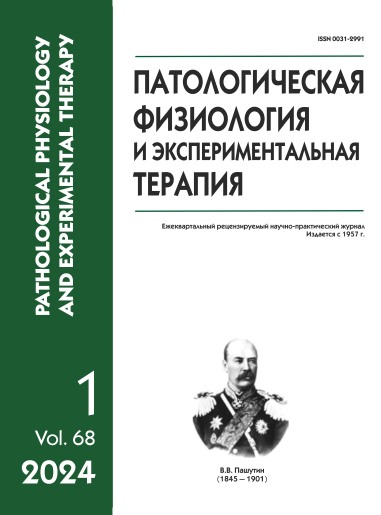Neutrophil extracellular traps in inflammatory diseases of the abdominal cavity
Abstract
The development of infectious complications in patients with inflammatory diseases is determined by how effective protective reaction the patient's neutrophils will develop upon contact with the pathogen. The body's anti-infective resistance is largely determined by the willingness of neutrophils to form neutrophilic networks capable of effectively capturing pathogens.
Aim. Determination of parameters of neutrophil extracellular traps (NETs) in patients with inflammatory diseases of the abdominal cavity.
Patients and methods. 28 operated patients with various forms of abdominal inflammation and 6 therapeutic patients with ulcerative colitis were examined, 6 patients were examined upon admission. Neutrophils were isolated using gradient centrifugation. To calculate the NETs, fluorescence microscopy with the dye SYBR Green (Evrogen; Russia), which specifically interacts with double-stranded DNA, was used. The functional activity of NETs was determined in the Klebsiella pneumoniae capture test (ATCC 700603).
Results. In the study of patients in the postoperative period, it was found that in acute appendicitis/abscess, acute cholecystitis and acute pancreatitis/pancreonecrosis, similar amounts of NETs are found - 12,63±2,13%, 15,66±2,81% and 12.64±2.73%. In the same groups of patients, significant differences in the size of the NETs are recorded, which reach 46.82±6.70 microns, 73.62±16.29 microns and 96.84±27.17 microns, respectively. The increase in the size of the NETs in these groups of patients is explained by the presence, in addition to network-like structures, additionally filamentous, fibrous and cloud-like neutrophil extracellular structures. A group of patients with nonspecific ulcerative colitis receiving conservative treatment (comparison group) shows a tendency to decrease the size of the NEL to a value of 31.96±14.75 microns. A study of the functional activity of NETs shows that its decrease precedes the development of a septic condition (using the example of an identified clinical case).
Conclusion. All, without exception, the studied nosological forms of inflammation in the abdominal cavity are accompanied by the formation of NETs in the form of neutrophilic networks. In addition to neutrophilic networks, inflammation induces the formation of NETs in the form of single strands, fibers and clouds form in some patients. The quantitative parameters of the NETs correlate with the size and spread of the inflammatory focus to neighboring anatomical areas. On the example of the described clinical case, a sharp decrease in the functional activity of NETs was found, which preceded the development of a septic complication. There is a connection between the initially weakened functional activity of NETs and the development of septic complications in the patient in the postoperative period.
Downloads
References
2. Kazimirskii AN, Salmasi JM, Poryadin GV. Antiviral system of innate immunity: COVID-19 pathogenesis and treatment. Bulletin of RSMU. 2020; (5): 5–13. DOI: 10.24075/brsmu.2020.054
3. Kazimirskii AN, Salmasi ZhM, Poryadin GV, Panina MI, Larina VN , Stupin VA, Kukes IV, Kim AE, Titova EG, Rogozhina LS, Stodelova EA, Rogacheva VV. IgG Stimulates the Formation of Neutrophil Extracellular Traps and Modifies Their Structure. Bull Exp Biol Med. 2023 Apr; 174(6):806-809. DOI: 10.1007/s10517-023-05794-2.
4. Lederer AK, Pisarski P, Kousoulas L, Fichtner-Feigl S, Hess C, Huber R. Postoperative changes of the microbiome: are surgical complications related to the gut flora? A systematic review. BMC Surg. 2017;17(1):125. DOI:10.1186/s12893-017-0325-8
5. Mohri Y, Tanaka K, Toiyama Y, Ohi M, Yasuda H, Inoue Y, Kusunoki M. Impact of Preoperative Neutrophil to Lymphocyte Ratio and Postoperative Infectious Complications on Survival After Curative Gastrectomy for Gastric Cancer: A Single Institutional Cohort Study. Medicine (Baltimore). 2016 Mar;95(11):e3125. DOI: 10.1097/MD.0000000000003125.
6. Kamonvarapitak T, Matsuda A, Matsumoto S, Jamjittrong S, Sakurazawa N, Kawano Y, Yamada T, Suzuki H, Miyashita M, Yoshida H. Preoperative lymphocyte-to-monocyte ratio predicts postoperative infectious complications after laparoscopic colorectal cancer surgery. Int J Clin Oncol. 2020 Apr;25(4):633-640. DOI: 10.1007/s10147-019-01583-y.
7. Vasavada B, Patel H. Postoperative serum procalcitonin versus C-reactive protein as a marker of postoperative infectious complications in pancreatic surgery: a meta-analysis. ANZ J Surg. 2021;91(5):E260-E270. DOI:10.1111/ans.16639
8. Medina-Fernández FJ, Garcilazo-Arismendi DJ, García-Martín R, et al. Validation in colorectal procedures of a useful novel approach for the use of C-reactive protein in postoperative infectious complications. Colorectal Dis. 2016;18(3):O111-O118.
DOI:10.1111/codi.13284
9. Řezáč T, Stašek M, Zbořil P, Špička P. The role of CRP in the diagnosis of postoperative complications in rectal surgery. Pol Przegl Chir. 2021; 93(5):1-7.
DOI: 10.5604/01.3001.0014.6591. PMID: 34552029
10. Sousa ÁFL, Bim LL, Hermann PRS, Fronteira I, Andrade D. Late postoperative complications in surgical patients: an integrative review. Rev Bras Enferm. 2020;73(5):e20190290. DOI:10.1590/0034-7167-2019-0290






